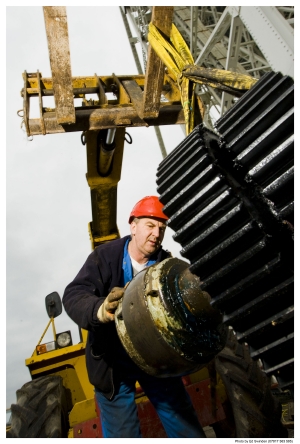Feb 4 2008
Engineers at The University of Manchester's Jodrell Bank Observatory in Cheshire needed more than just a jack and a brace when a steel tyre on the famous Lovell radio telescope cracked.

It wasn't a case of popping down to the local garage either - a whole new wheel had to be specially manufactured in Rotherham and took around three weeks to arrive at the observatory.
For several weeks the telescope was jacked up - although this didn't stop astronomers making their observations at the landmark site, which boasts three other telescopes plus another five spread across England in the giant MERLIN network.
Jodrell Bank engineer Chris Scott, who was in charge of overseeing the astronomical pit stop said: "The Telescope has 64 wheels, each weighing over one tonne, so I'm glad to say this is not a job we have to do every week!"
Chris is hoping the new wheel lasts as long as the old one, which had been in constant use since the Telescope was completed in October 1957, and is only the second wheel that has needed changing in that time.
Dr Richard Davis, the Jodrell Bank astronomer responsible for looking after developments of the Lovell Telescope, said: "It's wonderful to see the telescope back in operation after its enforced layoff these last few weeks.
"Although it's 50 years old, it is actually more capable than ever and plays a significant role in world astronomy as the third-largest steerable telescope and the heart of the UK's national radio astronomy facility."
For over 50 years the giant Lovell Telescope at Jodrell Bank, a Grade I listed building, has been a familiar feature of the Cheshire landscape and an internationally renowned landmark in the world of astronomy. It is named after Sir Bernard Lovell, 94, who originally conceived the idea for the telescope and oversaw its construction.
Its first act was to track the rocket that carried Sputnik I into space on 4 October 1957. Ever since it has been quietly probing the depths of space, a symbol of our wish to understand the universe in which we live. Even now, it remains one of the biggest and most powerful radio telescopes in the world, spending most of its time investigating cosmic phenomena which were undreamed of when it was first conceived.
It takes a huge 5,300 litres of paint to give the famous telescope three coats of paint.
The Lovell Telescope will play a key part in Jodrell Bank's new e-MERLIN telescope due to see first light later this year.
e-MERLIN is actually seven radio telescopes spread 217km across England and now connected by optical fibres.
When it becomes operational it will be the world's most powerful array of radio telescopes, capable of probing the furthest reaches of the universe.